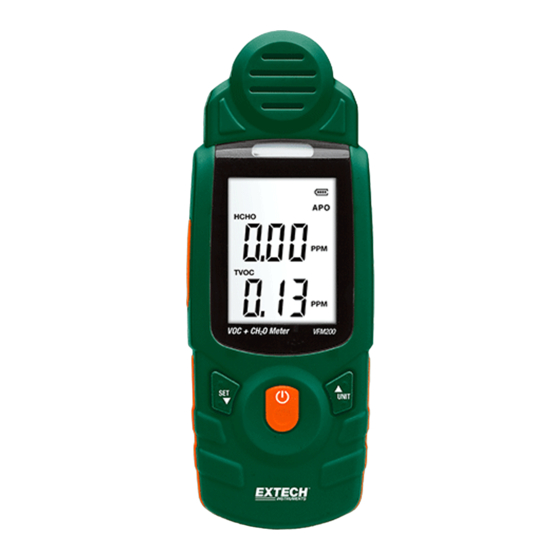Summary of Contents for Extech Instruments VFM200
- Page 1 User Manual Formaldehyde (HCHO or CH 0) and Total Volatile Organic Compounds (TVOC) Tester Model VFM200 Additional User Manual Translations available at www.extech.com ...
-
Page 2: Meter Description
Introduction Thank you for selecting the Extech Instruments Model VFM200. The VFM200 measures HCHO (formaldehyde) and TVOC (Total Volatile Organic Compounds). Potential sources for TVOCs include paints, finishes, adhesives, cigarette smoke, pesticides, personal care products, car exhaust, new furnishings, wall coverings, household cleansers, and cooking fuels. Chemicals include: Acetone, Ethylene Glycol, Formaldehyde, Xylene, 1,3‐butadiene, Tetrachloroethene, Hydrogen Sulfide, Ammonia, Toluene, Benzene, Methylene Chloride, Perchloroethylene, and MTBE. This device is shipped fully tested and calibrated and, with proper use, will provide years of reliable service. Please visit our website (www.extech.com) to check for the latest version of this User Guide, Product Updates, and Customer Support. Features Fuel Cell Formaldehyde Sensor Technology High accuracy measurements Backlit LCD display Real‐time display of HCHO (formaldehyde) concentration in air Real‐ time display of TVOC (Total Volatile Organic Compounds) concentration in air Two unit selections (PPM, mg/m³) Audio‐visual High and Low Alarms for HCHO Auto power off Description METER DESCRIPTION HCHO sensor (front) AC Adaptor jack (under flap) Down arrow and Alarm Setup button Battery compartment (rear) ON‐OFF button (also used in Alarm Setup) Up arrow and UNIT selection button Backlit Display ... -
Page 3: Operation
(unless it has been disabled with the SET/▼ button). Press SET/▼ to silence the alarm beeper (when it is sounding) or to disable the beeper entirely. When disabled, the displayed beeper symbol is switched off. ALARM SETUP (HCHO only) Low Alarm Setup Long press the SET/▼ button to enter the setup mode. The low alarm icon will display and the LCD will show the low alarm threshold. Use the ▲ and ▼ buttons to adjust the low alarm threshold. Press the button to go to the high alarm setup screen. High Alarm Setup Use the ▲ and ▼ buttons to adjust the high alarm threshold. Press the button to return to the normal measurement mode. VFM200‐en‐GB_V1.2 12/16 ... -
Page 4: Control Buttons
CONTROL BUTTONS Short press the ▼SET button to silence the beeper (when it is sounding) or to disable/enable the alarm beeper. This button is also used as a down arrow to change the high and low Alarm threshold values in the Alarm Setup mode. Long press the ▼SET button to enter the Alarm Setup Mode (See Alarm Setup section). Short press the ▲ UNIT button to change the unit of measure (PPM or mg/m³) or to use it as an up arrow to set the alarm threshold values in the Alarm Setup mode. SAFETY Do not store or use the instrument in an environment where corrosive gas is present. Do not obstruct the sensors when in use. Use only the supplied lithium‐ion battery to power the meter. Use only the supplied AC adapter/battery charger to charge the lithium‐ion battery. BATTERY CHARGE and REPLACEMENT When the battery requires charging, plug the supplied battery charger into the meter (left side, under flap) and to a source of AC power. A full charge requires 2 hours. To replace the battery, open the rear battery compartment and replace the Polymer lithium‐ion battery (7.4V 1300mAh). Re‐assemble the meter before use (part# VPC‐BATT) Battery Safety Notes: Please dispose of batteries responsibly; never dispose of batteries in a fire, batteries may explode or leak. If the meter is not to be used for 60 days or more, remove the battery and store separately. Never dispose of used batteries or rechargeable batteries in household waste. As consumers, users are legally required to take used batteries to appropriate collection sites, the retail store where the batteries were purchased, or wherever batteries are sold. Disposal: Do not dispose of this instrument in household waste. The user is obligated to take end‐of‐ life devices to a designated collection point for the disposal of electrical and electronic equipment. CLEANING AND STORAGE Periodically wipe the case with a damp cloth and mild detergent; do not use abrasives or solve nts. Please remove the battery if the meter is stored for a long period of time. VFM200‐en‐GB_V1.2 12/16 ... -
Page 5: Specifications
Sensor Professional Fuel Cell technology HCHO Range 0.00 to 5.00 mg/m³ (or PPM) HCHO Resolution 0.01 mg/m3 (or PPM) HCHO Basic Accuracy ±5% FS TVOC Range 0.00 to 9.99 mg/m³ (or PPM) TVOC Resolution 0.01 mg/m³ (or PPM) TVOC Basic Accuracy ±5% FS Response Time ≤ 2 seconds Operating Temperature 0°C to 40°C (32 to 104°F) Storage Temperature ‐10°C to 60°C (14 to 140°F) Power Supply Rechargeable Polymer lithium‐ion battery (7.4V 1300mAh) Battery Charge Time Approx. 3 hours with AC adapter Battery 7.4V 1300mAh (part # VPC‐BATT) Dimensions 165 x 60 x 25mm (6.5 x 2.4 x 1.0 in.) Weight 584g (20.6 oz.) Copyright © 2016 FLIR Systems, Inc. All rights reserved including the right of reproduction in whole or in part in any form ISO‐9001 Certified www.extech.com VFM200‐en‐GB_V1.2 12/16 ...












Need help?
Do you have a question about the VFM200 and is the answer not in the manual?
Questions and answers